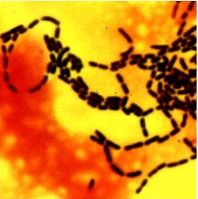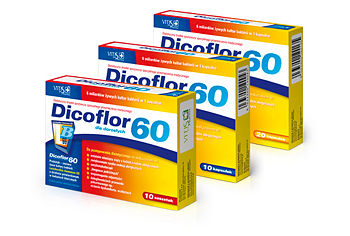Lactobacillus rhamnosus
For the course duration, the article is closed to outside editing. Of course you can always leave comments on the discussion page. The anticipated date of course completion is May 21, 2009. One month after that date at the latest, this notice shall be removed. Besides, many other Citizendium articles welcome your collaboration! |
| Lactobacillus rhamnosus GG | ||||||||||||||
|---|---|---|---|---|---|---|---|---|---|---|---|---|---|---|
 | ||||||||||||||
| Scientific classification | ||||||||||||||
| ||||||||||||||
| Binomial name | ||||||||||||||
| Lactobacillus rhamnosus GG |
Description and significance
Lactobacillus rhamnosus GG (LGG) was isolated in 1983 from a healthy human and was indicated to be a strain of Lactobacillus rhamnosus by Sherwood Gorbach and Barry Goldin. The "GG" is attributed to the scientists who made this discovery. [1] . L.rhamnosus GG is a probiotic bacteria known for its beneficial effects on the intestinal tract and can also boost a person's immune system and fight against intestinal pathogens. This helpful bacterium is said to balance the microfauna of the gastrointestinal tract. LGG is a unique bacteria because unlike other many other probiotic bacteria which die before reaching the intestine, LGG can survive in highly acidic environments like the stomach and therefore can make it to the intestine. Therefore, Gorbach and Goldin chose LGG as the ideal probiotic after testing thousands of strains for "health promoting" characteristics. [2] It can be taken in orally and then it attaches itself to the gastrointestinal membrane.[3] LGG can stimulate antibody production, enhances phagocytosis (a process in which a macrophage cell engulfs foreign invaders), and modifies production of cytokines which are important proteins in the immune response. LGG is also known to decrease the proliferation of carcinogenic elements by other bacteria living in the intestine. [4] In addition, in 2005 LGG was used to treat gastrointestinal carriage of vancomycin-resistant enterococci in patients with kidney problems. [5] L. rhamnosus GG has shown to shorten the duration of rotavirus diarrhea (Guandalini et. al 2000), relieve inflammatory bowel disease (Gupta et. al 2000), and treat and prevent allergies. (Kalliomaki et al. 2001b) LGG can suppress bacterial enzyme activity, while eliminate certain components of the normal intestinal flora which in turn benefits the person. It also produces an antimicrobial substance active against a number of different bacteria that are harmful to humans such as Escherichia coli Salmonella spp., Clostridium spp., Streptococcus spp., and Bacteroides spp.[6] Since it has so many positive effects on the human body, it is now available to buy in dairy products or in form of capsules to ingest orally.
Genome structure
The genomic sequence of Lactobacillus rhamnosus GG consists of over three million nucleotides which make up approximately 3100 genes. Compared to other lactic acid bacteria, this genome is somewhat larger, allowing LGG to propogate a greater diversity of qualities which can be the reason it can induce a larger variety of qualities when compared to other probiotic bacteria.[7] Like most other bacteria, LGG has a double stranded circular DNA.
Cell structure and metabolism
Lactobacillus rhamnosus GG is a rod shaped, gram positive, nonmotile faculative aerobic bacterium that ferments lactic acid from sugars.
Ecology
LGG can survive acidic environments and bile digestion and has been shown to reside in the human gastrointestinal tracts.[8]. On rare occasion, LGG has been found in the sexual reproductive system of women. However, LGG should not be considered to help against urinary tract infections because this bacterium does not attach efficiently to the vaginal epithelium.[9] Recent studies also indicate that LGG can be found in the oral cavity preventing dental carries. (carries research paper)
Commercial Importance
Despite all of L. rhamnosus GG positive attributes and the beneficial effects it can have on the human body, it not not found in the majority of the population. However, there are several of ways to get this friendly bacteria into the gut such as eating most dairy products, as well as fruit drinks. Along with food, a person may also take pills of Dicoflor 60 which contains 6 billion LGG bacteria in one capsule. In addition to Dicoflor, there are many other companies that generate compacted capsules of L. rhamnosus such as Culturelle.
Current Research
L. rhmnosus GG is the most studied probiotic bacteria today, especially for its positive effects on the gastrointestinal tract. A lot of research is being conducted on the effects it has on the gastrointestinal tract and its effect on immunity. Some older studies incorporating the benefits of LGG shows its ability to reduce inflammation of the intestine in children with cystic fibrosis. Studies have also shown how LGG can improve the efficacy of several vaccines such as the booster polio vaccination. More recently, the National Institute of Health is researching weather LGG improves immune response to the flu vaccine. Another study that currently in progress is examining if giving LGG to pregnant women who exhibit a family history of asthma reduces the chance of thier new born infants having asthma. [10]
Probiotics: an overview of beneficial effects
Is Lactobacillus GG Helpful in Children with Crohn's disease? Results of a Preliminary, Open-Label Study
Lactobacillus supplemaentation for diarrhoea related to study chemotherapy of colorectal cancer: a randomised study
more info pending
References
Technical Difficulties. All references will be reposted within a few days and all sections will be further contributed to.
- ↑ http://en.wikipedia.org/wiki/Lactobacillus_rhamnosus
- ↑ http://www.buyprobiotics.net/Culturelle_lactobacillus_GG.shtml
- ↑ National Cancer Institute. NCI Drug Dictionary. http://www.cancer.gov/Templates/drugdictionary.aspx?CdrID=468840
- ↑ Young, Rose. Vitamin Research Products. L. rhamnosus GG, Powerful Probiotic Strenghs Digestion and Immunity. 2009.
- ↑ http://en.wikipedia.org/wiki/Lactobacillus_rhamnosus
- ↑ Weese, SJ and Anderson, MEC. Preliminary evaluation of Lactobacillus rhamnosus strain GG, a potential probiotic in dogs. The Canadian Veterinary Journal. 2002 October; 43(10): 771–774. http://www.pubmedcentral.nih.gov/articlerender.fcgi?artid=339608#r25-11
- ↑ Nutraceuticals World. Valio decodes genome sequence of LGG. 2007 http://www.highbeam.com/doc/1G1-171326342.html
- ↑ Weese, SJ and Anderson, MEC. Preliminary evaluation of Lactobacillus rhamnosus strain GG, a potential probiotic in dogs. The Canadian Veterinary Journal. 2002 October; 43(10): 771–774
- ↑ Colodner, Rau and Edelstein, Hana. Vaginal colonization by orally administered Lactobacillus rhamnosus GG. The Israel Medical Association journal : IMAJ 2003;5(11):767-9.
- ↑ National Cancer Institute. NCI Drug Dictionary. http://www.cancer.gov/Templates/drugdictionary.aspx?CdrID=468840
- NCI Drug Dictionary, "Lactobacillus rhamnosus GG", National Cancer Dictionary. Retrieved on 2009-04-20
- Osterlund, P.; T. Ruotsalainen & R. Korpela (2007), "Lactobacillus supplementation for diarhoea related to chemotherapy of colorectal cancer: a randomised study", British Journal of Cancer 97: 6
Technical Difficulties. All references will be reposted within a few days and all sections will be further contributed to.
